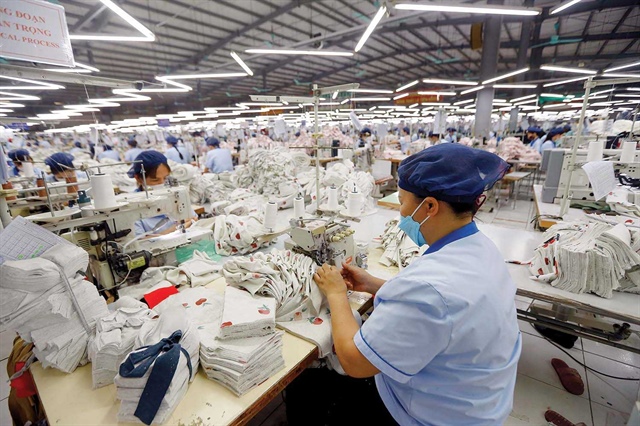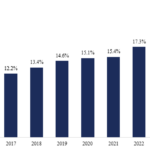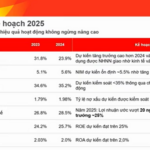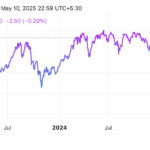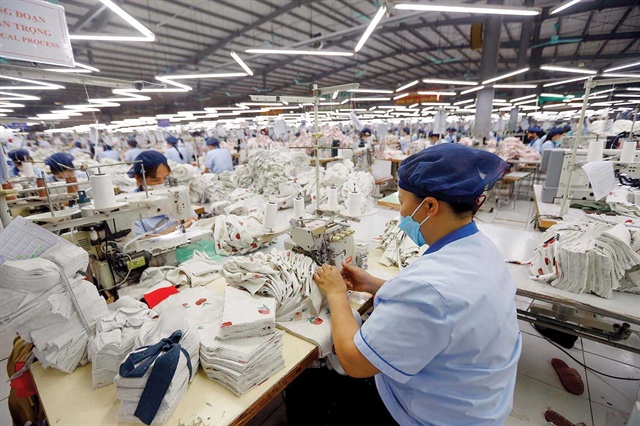
In 2025, the textile and garment industry’s exports are expected to see better growth opportunities as the main import markets such as the US and EU recover economically, and consumer spending improves. Image source: moit.gov.vn |
Lessons from various countries have shown that unsustainable growth can lead to long-lasting consequences and even slow down the development process.
Macroeconomic Instability and Asset Bubbles
Rapid economic growth can pose serious macroeconomic risks, especially macroeconomic instability, high inflation, asset bubbles, increased public debt, and the risk of unsustainable growth. As the economy expands rapidly, investment and spending demands will also increase, creating significant inflationary pressure on the demand side, devaluing the currency, and increasing the country’s foreign debt burden.
Lack of control and direction in investment can lead to widespread and scattered investment, reducing the efficiency of resource utilization. When enterprises and localities compete to achieve growth targets, capital may be allocated in a less strategic manner, resulting in many inefficient and wasteful projects. Consequently, numerous industrial parks, infrastructure projects, and new urban areas may be built but remain underutilized, leading to significant waste. The occurrence of “abandoned golden land,” ghost towns, and underperforming industrial parks in many localities highlights the lack of proper planning, regulation, and investment allocation guidance.
Additionally, if investment flows are not effectively controlled, asset bubbles may appear in the market, especially in the real estate and securities sectors. When too many resources are drawn into sectors that offer quick but unsustainable profits, the economy will lack long-term development momentum and become prone to bubble-burst cycles. As asset values rise far beyond their intrinsic worth, the risk of economic crisis becomes imminent. Furthermore, excessive credit expansion and borrowing for investment and consumption can increase both public and private debt burdens, pushing the banking system into a state of high non-performing loans and weakening the country’s financial system.
In reality, the Vietnamese economic vehicle has never been designed to operate at such high speeds, as many internal weaknesses remain unresolved.
Emerging Social Challenges
Apart from economic risks, rapid growth also presents significant social challenges. The wealth gap may widen if the majority of the benefits from growth are concentrated among a small group of large enterprises and investors, while most small businesses and workers do not reap proportional gains. This inequality not only reduces access to economic resources but also has the potential to fuel social unrest and erode the trust of a segment of the population.
Moreover, when the economy’s competitive advantage still relies on cheap labor rather than productivity, the pressure to maintain a high growth rate may lead many businesses to exploit this advantage excessively, negatively affecting the health and quality of life of workers. This perpetuates Vietnam’s vicious cycle of low-skilled labor, low productivity, and low income. Without a synchronized and proactive strategy to enhance human resource quality, the country’s economy risks being trapped in a quantity-over-quality growth model, limiting its development potential and making it difficult to sustain rapid growth in the long term.
Negative Environmental and Resource Impact
Uncontrolled rapid economic growth can lead to resource depletion and environmental pollution, severely affecting long-term sustainable development. The widespread expansion of economic sectors, including industry and mining, can accelerate resource depletion, degrade ecosystems, and disrupt natural balance. When forests are cleared for tourism development, industrial production, or agricultural land expansion, the risks of landslides, floods, and erosion become more severe, directly threatening the livelihoods of local communities and biodiversity.
Additionally, the rapid development of industrial parks and urban areas can exacerbate environmental pollution. More worryingly, chasing growth without a focus on sustainability will aggravate existing environmental challenges such as rising sea levels, droughts, salinity intrusion, and natural disasters. As ecosystems deteriorate, the economy’s ability to adapt to climate change diminishes, and many may face the risk of losing their agricultural land and livelihoods.
Therefore, to ensure that economic growth does not come at the expense of the environment, the government needs to implement synchronized policies aimed at a green growth model. This includes encouraging the use of renewable energy, improving resource efficiency, and tightening environmental protection regulations.
Negative Impacts, Corruption
The pressure to maintain a high growth rate can lead to hasty and opaque policy formulation, creating opportunities for corruption and vested interests. Many policies may be designed to favor certain investors and businesses, especially large corporations, rather than providing equal opportunities for all enterprises, including small and medium-sized enterprises. Large conglomerates, particularly those with close ties to the public sector, can influence policy shaping, undermining economic fairness and eroding the trust of businesses and citizens in the state management system.
Achieving Rapid Growth on a Sustainable Foundation
Instead of merely pursuing high growth targets hastily, the government should focus on the quality of growth over quantity. Firstly, it is crucial to control inflation, maintain credit quality, and ensure macroeconomic stability to safeguard the country’s financial system, including the banking and public finance sectors. The State Bank should regulate money and credit supply reasonably, avoiding excessive capital injection into sectors prone to asset bubbles. The government also needs to maintain tight fiscal discipline, enforce hard budget constraints, and concentrate investments on truly effective projects instead of wasteful scattered investments.
One of the fundamental solutions is to develop a high-quality workforce, improve the education system, and enhance vocational training to meet the demands of the labor market. Additionally, promoting green economic development, tightening environmental standards for businesses, investing in renewable energy, and protecting the country’s precious resources are essential steps. Furthermore, institutional reform efforts should be intensified, economic policies should be transparent, and corruption and vested interests should be curbed to establish a solid foundation for rapid and sustainable economic growth. The government needs to foster a healthy and fair business environment, supporting the development of private enterprises and their deeper integration into the global value chain.
In conclusion, while rapid economic growth brings many benefits, it can also lead to a series of financial, social, environmental, and institutional risks if not accompanied by a reasonable vision and strategy. Therefore, alongside pursuing high growth targets, the government should prioritize sustainability, ensuring that growth is not only rapid but also stable and inclusive. This calls for a balanced approach that includes managing financial risks, curbing bad debt and scattered investments, developing a highly skilled workforce to meet the demands of the digital economy, enhancing scientific and technological potential to drive innovation, improving the business environment to ensure fair and transparent competition, strengthening national competitiveness to solidify Vietnam’s position in the context of global integration, and protecting the environment and preserving natural resources for future generations. Only by integrating these factors can Vietnam achieve an economy that is not only robust but also sustainable, autonomous, and resilient to global fluctuations.
Do Thien Anh Tuan (Fulbright School of Public Policy and Management)
Unleashing the Private Sector: Removing the Brakes for a True Economic Breakthrough
In the context of Vietnam’s intensified reform and international integration, the private sector is increasingly asserting its pivotal role in the economy. However, to truly unleash its potential, a comprehensive strategy is needed to address the existing constraints. In an interview with the Government Online Newspaper, Professor Vu Minh Khuong, a lecturer at the Lee Kuan Yew School of Public Policy (National University of Singapore), shared his insights on the obstacles, opportunities, and directions to enable the private sector to become a driving force for the country’s development.
The Fall of the Phuc Son Group: Prosecuting Five Former Provincial Party Chiefs
Over a year of investigation into the Phuoc Son Corporation scandal, the Ministry of Public Security has concluded its probe and recommended the prosecution of 41 accused individuals, including several former Provincial Party Committee Secretaries.
The Debt Burden’s Drag on Economic Growth
Debt is a pivotal tool in the modern financial system, stimulating consumption and investment while contributing to economic growth. When managed prudently, credit enables businesses to expand their production, enhance operational efficiency, and improve labor income, thereby creating a positive ripple effect on the economy. However, debt growth is not a panacea for perpetual expansion, as the burden of interest payments can become onerous.
The Prime Minister: Proactive and Agile in the Face of Global Economic Flux
As economic and trade policies evolve globally, the Prime Minister has urged for a proactive and agile approach. We must closely monitor these dynamic policy changes and respond with flexibility and feasibility for each market. To thrive in this evolving landscape, we should focus on fostering stronger partnerships with key players, reviewing tax policies, and strategically investing in high-tech sectors and innovation.
“HDBank Aims High: Targeting Profits of Over 20 Trillion VND by 2025 with Plans to Maintain Similar Dividend Payouts”
At the investor conference held on February 18, 2025, representatives from HDBank, one of Vietnam’s leading joint-stock commercial banks, presented an insightful overview of the country’s economic growth potential, along with the bank’s specific plans for the year 2025.


























